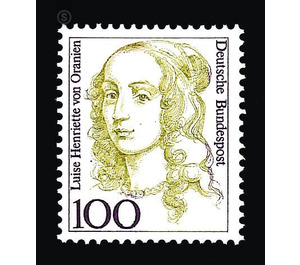Permanent series: Women of German History - Germany / Federal Republic of Germany 1994 - 100 Pfennig
Theme: Health & Human
| Country | Germany / Federal Republic of Germany |
| Issue Date | 1994 |
| Face Value | 100.00 |
| Color | brown white |
| Perforation | K 14 |
| Printing Type | 2-color Typography |
| Stamp Type | Postage stamp |
| Item Type | Stamp |
| Chronological Issue Number | 1629 |
| Chronological Chapter | GER-BRD |
| SID | 800227 |
| In 138 Wishlists | |
Luise Henriette was born on 27 November 1627 as the eldest daughter of Prince Friedrich Heinrich of Nassau-Orange in The Hague; her mother came from the Hessian manor house Solms-Braunfels. In the Calvinistic, yet cosmopolitan and art-loving parental home, she enjoyed a thorough education. On December 7, 1646, she married the young Elector Friedrich Wilhelm of Brandenburg. The connection with the House of Orange was mainly politically motivated for the later Great Elector, but the marriage was extremely happy. The Electress was a woman who knew how to work and whose practical, hands-on manner corresponded to the nature of her husband. In 1650 he transferred to her the office located north of Berlin Bötzow, which they immediately built a model company and even pulled profits from it. In the place called "Oranienburg" in her honor, she had a castle built and donated there in 1665 the first orphanage in Brandenburg-Prussia. Apart from these economic-social measures, Luise Henriette made little appearance externally. Nevertheless, she took a lively interest in the destiny of the country and her husband's pressing problems. Her own nature was marked by a deep religiosity and an unconditional trust in God, from which she drew comfort and strength for the Visitation of various kinds. Of their six children survived only the third son Friedrich (1657-1713), who proclaimed himself in 1701 the king in Prussia. Through him Luise Henriette became the ancestress of the Prussian kings and later German emperors. Her unstable health was a chore of her life. Not yet 40 years old, she died on June 18, 1667 in Berlin Castle and found her last resting place in the neighboring cathedral. (Text: Dr. Peter Letkemann, Secret State Archive of Prussian Cultural Heritage, Berlin)


